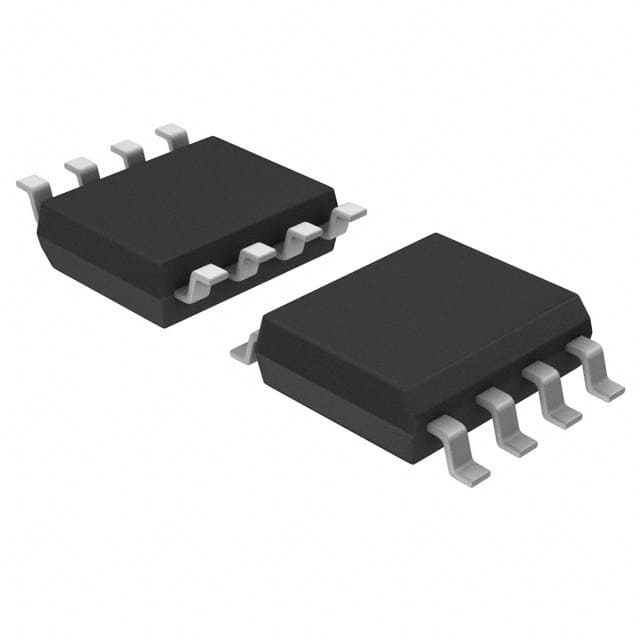Lihat spesifikasi untuk detail produk.

LM2903DR2G
Overview
Category: Integrated Circuits (ICs)
Use: LM2903DR2G is a dual differential comparator designed for use in industrial, automotive, and consumer applications. It is commonly used in voltage level detection, signal conditioning, and analog-to-digital conversion circuits.
Characteristics: - Low input offset voltage - Low input bias current - Wide supply voltage range - High output sink current capability - Rail-to-rail output swing
Package: SOIC-8
Essence: The LM2903DR2G is an essential component in electronic circuits that require precise comparison of two input voltages. It provides accurate and reliable results in various applications.
Packaging/Quantity: The LM2903DR2G is typically sold in reels or tubes containing 2500 units.
Specifications
- Supply Voltage Range: 2V to 36V
- Input Offset Voltage: ±1mV (maximum)
- Input Bias Current: ±25nA (maximum)
- Output Sink Current: 20mA (minimum)
- Operating Temperature Range: -40°C to +125°C
Pin Configuration
The LM2903DR2G has a total of 8 pins arranged as follows:
___________
V+ | | V-
IN(-) | | OUT
IN(+) | | GND
|___________|
Functional Features
Dual Comparator: The LM2903DR2G contains two independent comparators in a single package, allowing simultaneous comparison of two different input signals.
Open-Collector Outputs: The outputs of the comparators are open-collector, which enables easy interfacing with other digital or analog circuits.
Wide Supply Voltage Range: The LM2903DR2G can operate from a supply voltage as low as 2V, making it suitable for battery-powered applications.
Rail-to-Rail Output Swing: The output voltage can swing close to the supply rails, maximizing the dynamic range of the comparator.
Advantages and Disadvantages
Advantages: - Low input offset voltage ensures accurate comparison. - Wide supply voltage range allows flexibility in various applications. - Rail-to-rail output swing provides maximum output voltage range.
Disadvantages: - Limited output sink current capability compared to some other comparators. - Not suitable for high-frequency applications due to limited bandwidth.
Working Principles
The LM2903DR2G compares the voltages applied to its two input pins (IN(-) and IN(+)) and produces a digital output based on the comparison result. When the voltage at IN(+) is higher than IN(-), the output goes low (sink current flows). Conversely, when the voltage at IN(-) is higher, the output remains high (no sink current).
Detailed Application Field Plans
The LM2903DR2G finds applications in various fields, including:
Voltage Level Detection: It is used to detect and compare different voltage levels in power supplies, battery chargers, and audio amplifiers.
Signal Conditioning: The comparator is employed to condition analog signals before further processing or conversion.
Analog-to-Digital Conversion: It plays a crucial role in ADC circuits by comparing an analog input voltage with a reference voltage.
Automotive Electronics: The LM2903DR2G is widely used in automotive systems for monitoring and control purposes, such as speed sensing and motor control.
Detailed and Complete Alternative Models
Some alternative models that can be considered as alternatives to the LM2903DR2G are:
- LM339: Quad differential comparator with similar characteristics and pin configuration.
- LM393: Dual differential comparator with lower power consumption.
- LM311: Single high-speed differential comparator with a wider supply voltage range.
These alternatives provide similar functionality and can be used as replacements depending on specific requirements.
In conclusion, the LM2903DR2G is a versatile dual differential comparator that offers precise voltage comparison in various applications. Its low input offset voltage, wide supply voltage range, and rail-to-rail output swing make it a popular choice among designers. However, its limited output sink current capability and bandwidth may restrict its use in certain high-current or high-frequency applications.
Sebutkan 10 pertanyaan dan jawaban umum terkait penerapan LM2903DR2G dalam solusi teknis
Sure! Here are 10 common questions and answers related to the application of LM2903DR2G in technical solutions:
Question: What is LM2903DR2G?
- Answer: LM2903DR2G is a dual differential comparator IC that is commonly used in various technical applications.Question: What is the operating voltage range of LM2903DR2G?
- Answer: The operating voltage range of LM2903DR2G is typically between 2V and 36V.Question: Can LM2903DR2G be used as a voltage comparator?
- Answer: Yes, LM2903DR2G is primarily designed for voltage comparison applications.Question: What is the output type of LM2903DR2G?
- Answer: LM2903DR2G has an open-drain output, which means it can sink current but cannot source current.Question: What is the maximum output current of LM2903DR2G?
- Answer: The maximum output current of LM2903DR2G is typically around 16mA.Question: Is LM2903DR2G suitable for low-power applications?
- Answer: Yes, LM2903DR2G is known for its low power consumption, making it suitable for battery-powered devices.Question: Can LM2903DR2G operate in both single-supply and dual-supply configurations?
- Answer: Yes, LM2903DR2G can work with both single-supply and dual-supply voltages.Question: What is the response time of LM2903DR2G?
- Answer: The response time of LM2903DR2G is typically in the range of a few microseconds.Question: Can LM2903DR2G be used in automotive applications?
- Answer: Yes, LM2903DR2G is qualified for automotive applications and can operate in harsh environments.Question: Are there any specific precautions to consider when using LM2903DR2G?
- Answer: It is important to ensure proper decoupling and bypassing of power supply pins, as well as following the recommended operating conditions mentioned in the datasheet.
Please note that these answers are general and may vary depending on the specific application and requirements.

